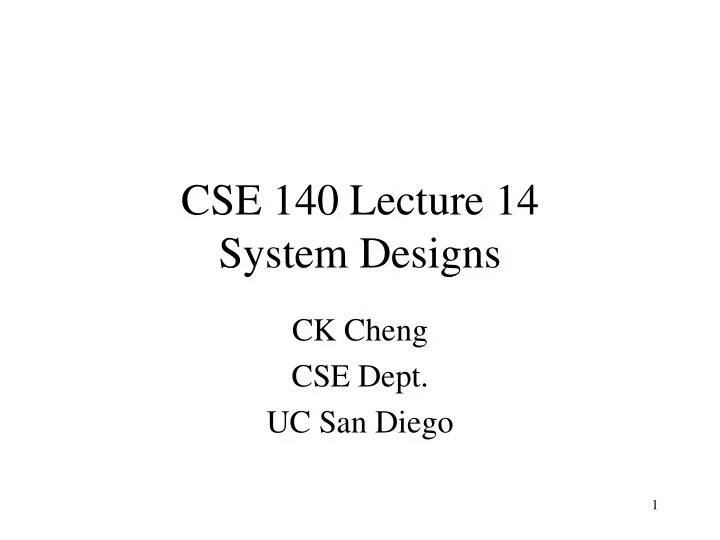

CSE 140 Lecture 14 System Designs CK Cheng CSE Dept. UC San Diego 1
System Designs •Introduction •Components •Spec •Implementation 2
Digital Designs vs Computer Architectures • Instruction Set (H.Chapter 6, CSE141) – Bottleneck: Silicon Area, Power • Data Path (H.Chapter 7.1-7.3) • Control Subsystem (H.Chapter 7.1-7.3) • Memory Management (Chapter 8, CSE141) – Bottleneck: IO, Memory Latency 3
Introduction • Methodology • Approach with success stories • Hierarchical designs with interface between the levels • Data Subsystem and Control Subsystem • For n-bit data, each operation takes n or more in complexity • Data subsystem carries out the data operations and transports • Control system sequences the data subsystem and itself. 4
I. Introduction n=64 n=64 Data Data Data Subsystem Inputs Outputs Control Conditions Signals Control Control Control Subsystem Outputs Inputs Start/Request Done/Acknowledgement 5
Introduction Functions Components Data Data storage Storage Modules Subsystem Data operations Operators Data transport Interconnections Control Control of data operations Sequential machines Control of data transports Subsystem Control of the sequential system 6
Data Subsystem Components • Storage • Operator • Interconnect 7
Components: Storage Modules, Register LD: Load D CLR: Clear CLK LD CLR Q Q(t+1) = (0, 0, .. , 0) if CLR = 1 = D if LD = 1 and CLR = 0 = Q(t) if LD = 0 and CLR = 0 8
Storage Component: Registers, Array of Registers D Registers: If C then R D LD C R Register Array: If C then R D address Sharing connections and controls D LD C Decoder address R 9
Storage Components: RAM, FIFO, LIFO RAM Size of RAM larger Decoder RAM Address than registers Performance is slower FIFO (First in first out) LIFO (Last in first out: Stack) 10
Functional Modules B A CASE Op-Sel Is When F1, Z <= A op1 B Operation When F2, Z <= A op2 B selection . . End CASE Example: Z CASE Op-Set Is Z <= (A + B)mod 2 n if Op-Sel=addition, Z <= (A - B)mod 2 n if Op-Sel=subtraction End CASE 11
Functional Modules CASE F Is B A When F=0, Z <= A When F=1, Z <= B End CASE F iClicker: The above function can be implemented by Z A.A vector of decoders B.A vector of multiplexers C.A RAM D.None of the above 12
Interconnect Modules (Wires and Switches) •Single Lines •Band of Wires •Shared Buses •Crossbar 1. Single line (shifting, time sharing) Shift Register Shift Register 13
2. Band of Wires (BUS) 3. Shared Bus switch switch switch switch ….. R1 R2 R3 Rn Switches x x x x DEMUX MUX c c d S S 1 2 3 .. n 1 2 3 .. n Rn Rn y y R1 R1 14
4. Crossbar (Multiple buses running horizontally) m simultaneous transfers are possible, but more expensive. 64 Bus 1 R1 Bus n Rn MUX1 MUX2 MUXn … 15
Program: 1. Objects (Registers, Outputs of combinational logic) 2. Operation (Logic, Add, Multiplication, DSP, and etc) 3. Assignment 4. Sequencing Example: Signal S1, S2, R[15:0]: FFs, Registers Z A + B: Registers, Adder, Interconnect R1 R2: Registers and Interconnect Begin, End: Control if ( ) then ( ), ENDIF: Control 16
S1 Ex. If C then R1 S1 Else R2 S2 R1 LD Endif; S2 C R2 If C1 then X A A B C Else X B + C Adder Endif If C2 then G X 1 0 C1 MUX Endif C2 G CLK 17
Implementation: Example AddModule(X, Y, Z, start, done) { Input X[15:0], Y[15:0] type bit-vector, start type boolean; Local-Object A[15:0], B[15:0] type bit-vector; Output Z[15:0] type bit-vector, done type boolean; S0: If start’ goto S0 || done 1; S1: A X || B Y || done 0; S2: Z Add(A, B) || goto S0; } Exercise: Go through the handshaking, data subsystem and control subsystem designs. 18
Recommend
More recommend